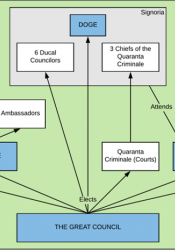The Council of Ten
Established in 1310 with the intent to preserve the peace and protect the people from abuses of power, the Council of Ten gained power throughout the early 14th century, rapidly becoming a “chief force of justice” (FitzSimons).
The members of the Council of Ten – like the Doge, all the members of the Senate and courts, and other government officials – were elected by the Great Council. In addition to those members, the Signoria – which includes the three chiefs of the Quaranta Criminale court, the six Ducal Councilors, and the Doge – were present at all meetings.
Among its purposes, the Council worked to counter any actions or plots that may be taken or made against the Republic. The body’s small size facilitated this role, enabling it to make quick decisions in relative secrecy. In 1319, The Council established its own police force, the Capi di Sestiere, which along with two previous forces, patrolled the six political divisions of Venice, pursuing criminals and enemies of the state alike. As such, the Council of Ten, along with the courts and heavy taxes, played an important role in preventing popular rebellion and maintaining peace and order.
Sources:
FitzSimmons, A. K. (2013, December). The Political, Economic, and Military Decline of Venice Leading Up to 1797. University of North Texas. Retrieved March 2018, from https://search.proquest.com/docview/1650621354?pq-origsite=primo
Horodowich, E. (Philadelphia). A Brief History of Venice. 2009: Running Press Book Publishers.
Image:
Created based on the information provided by the source above.

